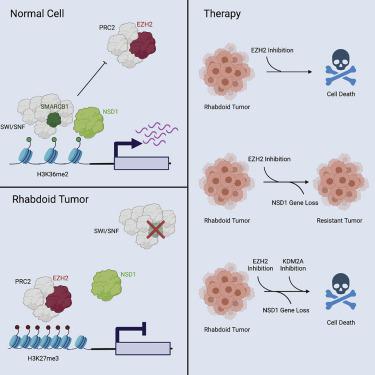Molecular Cell ( IF 16.0 ) Pub Date : 2022-05-09 , DOI: 10.1016/j.molcel.2022.04.015 Yiannis Drosos 1 , Jacquelyn A Myers 1 , Beisi Xu 2 , Kaeli M Mathias 1 , Emma C Beane 1 , Sandi Radko-Juettner 3 , Robert J Mobley 1 , Margaret E Larsen 1 , Federica Piccioni 4 , Xiaotu Ma 5 , Jonathan Low 6 , Baranda S Hansen 7 , Samuel T Peters 7 , Natarajan V Bhanu 8 , Sandeep K Dhanda 9 , Taosheng Chen 6 , Santhosh A Upadhyaya 9 , Shondra M Pruett-Miller 7 , David E Root 4 , Benjamin A Garcia 8 , Janet F Partridge 1 , Charles W M Roberts 3

|
Disruption of antagonism between SWI/SNF chromatin remodelers and polycomb repressor complexes drives the formation of numerous cancer types. Recently, an inhibitor of the polycomb protein EZH2 was approved for the treatment of a sarcoma mutant in the SWI/SNF subunit SMARCB1, but resistance occurs. Here, we performed CRISPR screens in SMARCB1-mutant rhabdoid tumor cells to identify genetic contributors to SWI/SNF-polycomb antagonism and potential resistance mechanisms. We found that loss of the H3K36 methyltransferase NSD1 caused resistance to EZH2 inhibition. We show that NSD1 antagonizes polycomb via cooperation with SWI/SNF and identify co-occurrence of NSD1 inactivation in SWI/SNF-defective cancers, indicating in vivo relevance. We demonstrate that H3K36me2 itself has an essential role in the activation of polycomb target genes as inhibition of the H3K36me2 demethylase KDM2A restores the efficacy of EZH2 inhibition in SWI/SNF-deficient cells lacking NSD1. Together our data expand the mechanistic understanding of SWI/SNF and polycomb interplay and identify NSD1 as the key for coordinating this transcriptional control.
中文翻译:

NSD1 介导 SWI/SNF 和多梳复合物之间的拮抗作用,并且是 EZH2 抑制时转录激活所必需的
SWI/SNF 染色质重塑剂和多梳阻遏物复合物之间拮抗作用的破坏导致多种癌症类型的形成。最近,多梳蛋白EZH2的抑制剂被批准用于治疗SWI/SNF亚基SMARCB1的肉瘤突变体,但出现了耐药性。在这里,我们在 SMARCB1 突变的横纹肌样肿瘤细胞中进行了 CRISPR 筛选,以确定 SWI/SNF-多梳拮抗作用和潜在耐药机制的遗传因素。我们发现 H3K36 甲基转移酶 NSD1 的缺失导致对 EZH2 抑制的抵抗。我们发现 NSD1 通过与 SWI/SNF 合作拮抗 Polycomb,并在 SWI/SNF 缺陷的癌症中同时发生 NSD1 失活,这表明在体内关联。我们证明,H3K36me2 本身在多梳靶基因的激活中具有重要作用,因为在缺乏 NSD1 的 SWI/SNF 缺陷细胞中,抑制 H3K36me2 去甲基酶 KDM2A 可以恢复 EZH2 抑制的功效。我们的数据共同扩展了对 SWI/SNF 和多梳相互作用的机制理解,并将 NSD1 确定为协调这种转录控制的关键。



























 京公网安备 11010802027423号
京公网安备 11010802027423号